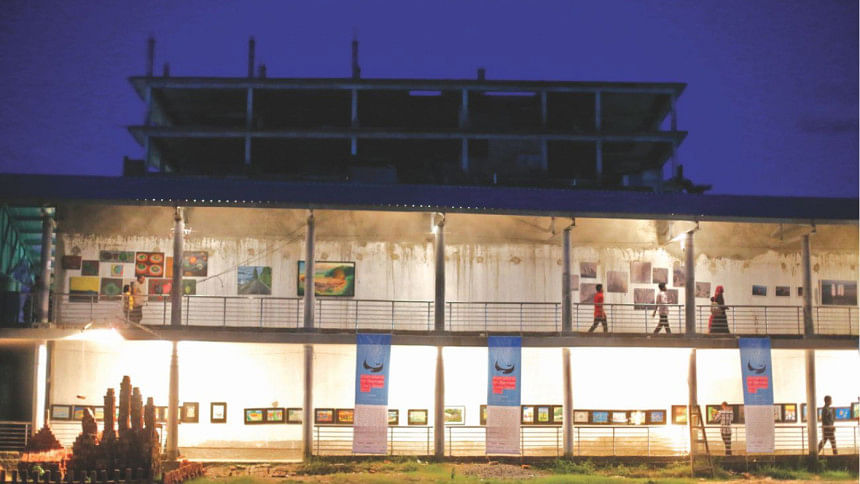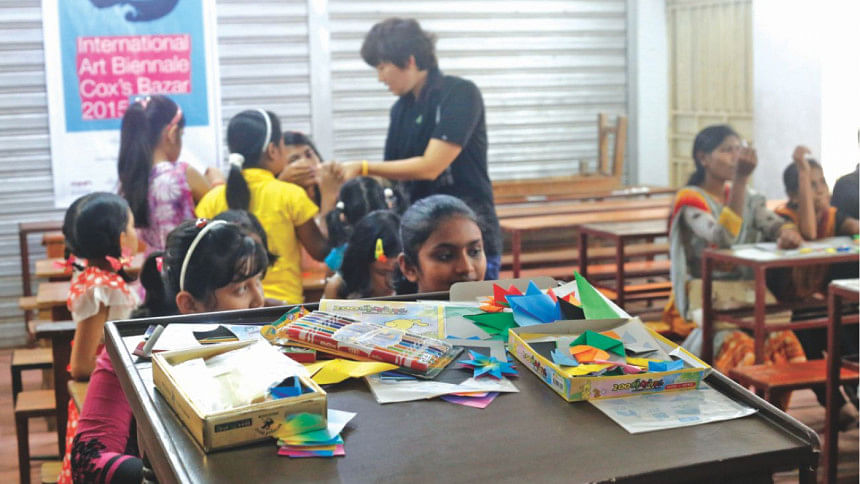ART, BY THE SHORE

Photo: Orchid Changma
The tranquil town of Cox's Bazaar recently came to life with art. The under construction Cox's Bazaar Institute and Public Library, otherwise empty and unused, was the centre of activities and vibrant colours. The International Art Biennale Cox's Bazaar 2015, a unique initiative to promote Bangladeshi artists and art practitioners, has been an extraordinary platform for young artists to demonstrate their genius. Besides exhibition of artworks; artists and scholars, from Bangladesh, India and South Korea, conducted workshops, stage-performances and talked about Bangladesh's art history and heritage.

"This kind of a large scale arrangement is not at all common outside of Dhaka. However, the festival was organised to promote and encourage promising artists who are otherwise under-represented and less privileged," says Amirul Rajiv, curator of the 4-day event. "Cox's Bazaar's rich, cultural heritage, diversity and scenic beauty also triggered us to choose this town as the venue of our very first initiative." Aranya Sharma and Sabyasachi Mistry were the co-organisers of International Art Biennale Cox's Bazar.
An exclusive creation, at the festival, was the artwork using new media -- one of the most powerful languages used by the young artists. Artistic photographs, video art, light installations, digital art were some of the centres of attractions for the audience and art critics.

Among many of these innovative works, Shimul Saha's light based installation titled 'We all are Dust in the Air' was much acclaimed by the art enthusiasts. The piece was made of engraved acrylic sheet, LEDs and wood, depicting a lot of the symbols that we use for social identification. The symbols, scattered in the frame, created a visual illusion of floating in the air. "Symbols only represent the dominating population and culture," says Saha. "For example, we are familiar with the male and female symbol, but we are not at all familiar with the symbol of the transgender. I have tried to depict the discrimination that exists in our society through symbols."

On the ground floor of the venue, many of the audience and critics were awestruck by the works of Rajib Datta. This young artist remade many of the famous and historic paintings and photographs using his own form of expression. For example, he recreated the famous painting "The Potato Eaters" and added red flowers in the painting and exquisitely generated the opposite emotions of beauty and sorrow.

On the same floor, there were works of Indian photographer Nirvair Singh who depicted the plight of the Rohingyas, one of the most persecuted peoples of the world, through his amazing photography skills. However, the audience was restricted from getting the opportunity to observe these superb artworks closely because these photographs were displayed on a wall outside the building which the audience could see only through barred windows. "We did this intentionally because Rohingyas are being tortured and oppressed right across our border but we have done nothing," explains Amirul Rajib. "To express this harsh reality, we have displayed the photos behind barred windows in protest of our silence about the oppression against the helpless, persecuted people."
A collective photography exhibition on the decaying ecology of the Sundarbans titled "Ah Sundarban" depicted the manmade destruction of the world's largest mangrove forest and ruthless killing of its wild lives. Scenic beauties of Cox's Bazaar, the longest sea beach of the world, and importance of preserving its natural features were also depicted in the artworks and lectures.

The festival also involved children in the art movement. The children's art exhibition was an important part of the festival and a gallery was dedicated to the paintings of school children mostly belonging to local schools and schools from nearby districts. The organisers also arranged two interactive workshops on puppetry and origami for the school children. Hyelyoung Lee and Sangmi Shin, two origami artists from South Korea conducted the workshop with 30 school children. "The children were wonderful!" says Lee. "After a brief training, the children created marvellous origami pieces which we decided to exhibit alongside other works in the festival. A puppetry workshop was held for the children by Jolpori Puppet Studio, later on staging a puppet show during the festival, along with the children.

An independent indigenous artist, Joydeb Roaja, from Khagrachhari, showed the development of life and culture on the hills through his exquisite stage performance. Jewel A Rob's passionate depiction of human emotion and Sagor Haldar's search for nirvana by purifying the human soul through fire, touched many a heart.


Many art organisations from all over the country participated and voluntarily worked for the programme. Among these organisations, Oriental Painting Study Group assisted to organise the festival. Exquisite post modern water colour paintings by four eminent artists from this group were displayed at the Biennale – namely Dr Malay Bala, Zahangir Alom, Amit Nandi and Gopal Saha. Malay Bala beautifully depicted the vignettes of Shakuntala while Zahangir Alom anatomising various facets of art 'ism' successfully assimilated and absorbed the trend of post modern painting. Gopal Saha's works highlighted social incongruence, morality and double-standards of human beings and Amit Nandi showcased decaying politics and perishable norms and values of a society. Besides this, The Daily Star, Prothom Alo, Depart, Open Art, DAP LS, Nitya Upohar, Agami Prokashoni, Dainik Cox's Bazaar, Cox's Bazaar Shangskritik Kendra and Digital Hospital also assisted to organise the festival.
The festival was organised without any corporate financing or banners of business conglomerates. In fact, it was arranged by enthusiastic artists and art practitioners, through their hard work and sheer dedication. The festival paved a way to creating a new platform for young artists, creating confidence amongst many to continue to create without pause. If the Government and our society come forward to encourage this kind of initiative, Bangladesh could very soon become the new hub of global renaissance of art and culture in the near future.

 For all latest news, follow The Daily Star's Google News channel.
For all latest news, follow The Daily Star's Google News channel. 



Comments